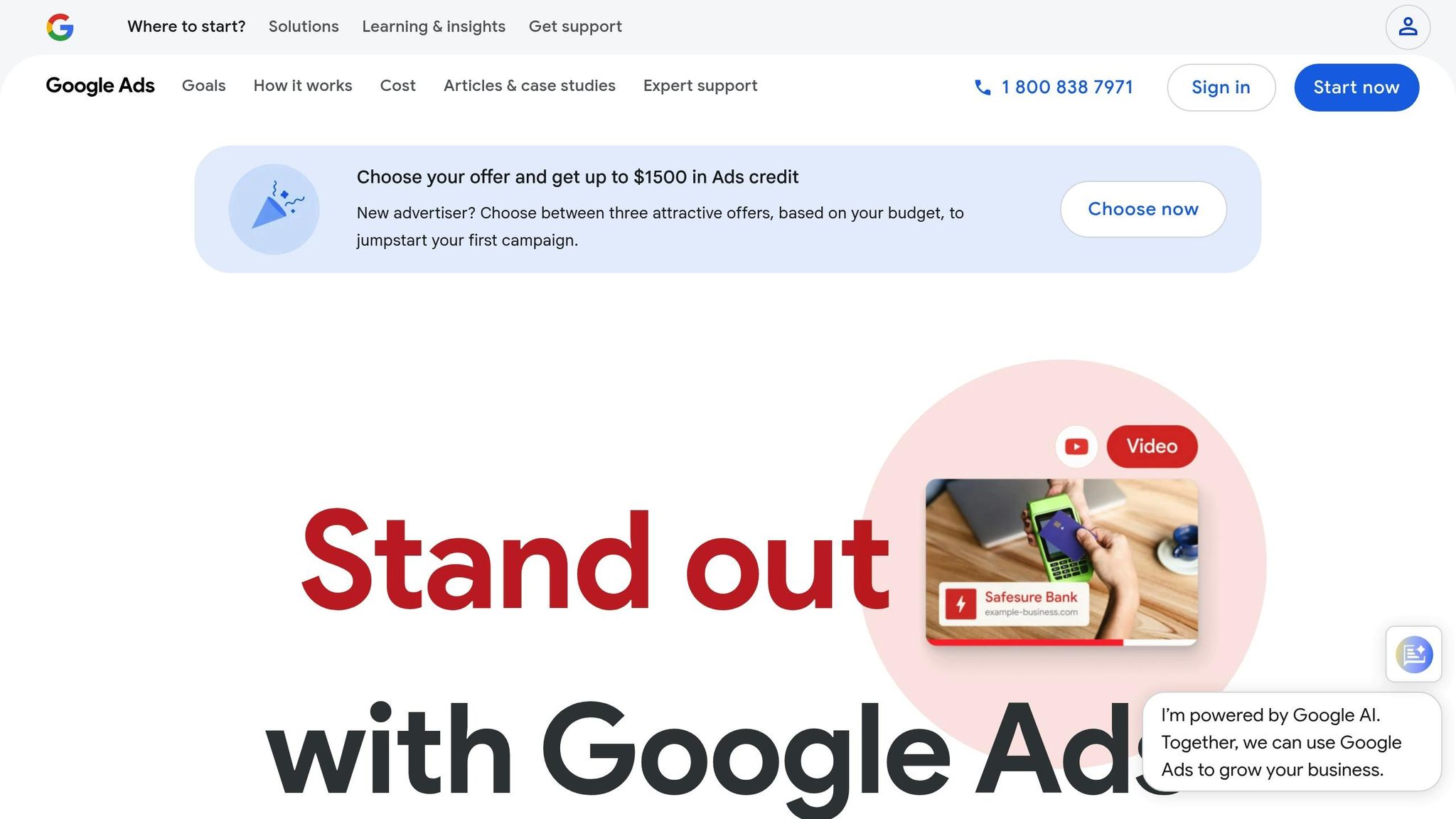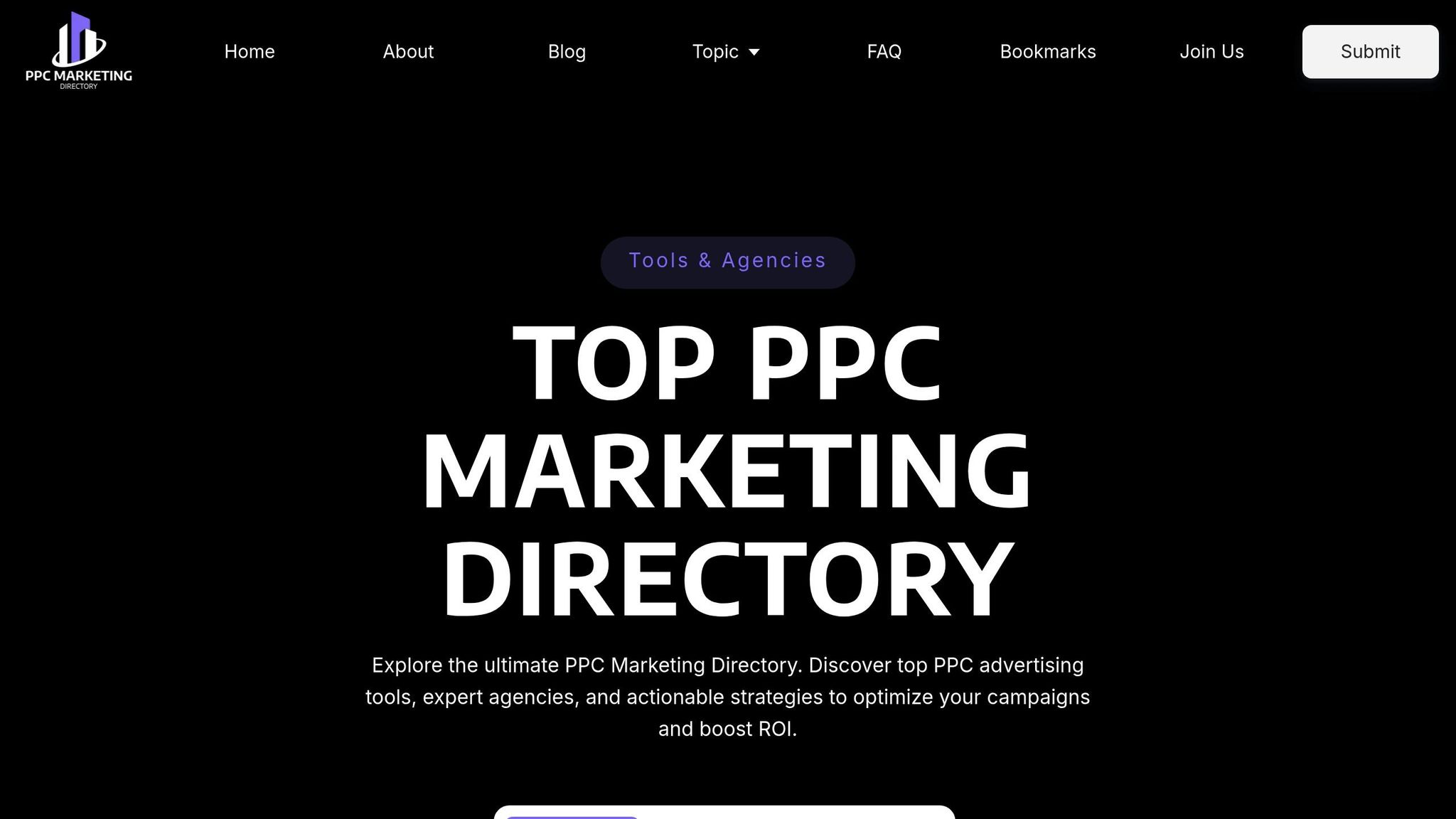Rule-based bid adjustments simplify PPC campaign management by using "if-then" logic to automate bid changes based on predefined conditions. This approach combines automation with manual control, making it easier to manage budgets, track performance, and adjust strategies. Advertisers set rules that trigger bid changes when specific metrics, like ROAS or CTR, hit certain thresholds. While offering transparency and precision, these systems require regular monitoring and careful rule design to avoid conflicts and maintain effectiveness.
Key Takeaways:
- What It Does: Automates bid adjustments using logical "if-then" rules.
- How It Works: Rules are based on performance metrics (e.g., ROAS, CTR) and contextual factors (e.g., device type, location).
- Advantages: Provides control, transparency, and targeted bidding adjustments.
- Challenges: Requires manual setup, ongoing monitoring, and struggles with rapid market changes.
- Best Use Cases: Maintaining ROAS/CPA targets, regulatory compliance, and time-based bidding.
Rule-based systems are ideal for advertisers seeking a balance between automation and manual oversight, especially for campaigns with steady performance or niche products. However, they may become cumbersome for large-scale, dynamic campaigns.
Bid Adjustments | Ultimate Google Ads Guide

How Rule-Based Bid Adjustments Work
Getting a handle on rule-based bid adjustments can make a big difference in campaign performance. These systems use a logical framework to process data and guide bidding decisions.
If-Then Rule Structure
At the heart of rule-based bid adjustments is a straightforward if-then logic. Each rule has two parts: a condition (the "if") and an action (the "then"). This setup creates a clear cause-and-effect process, making it easy to understand how and why adjustments are made.
Here’s an example: Let’s say a keyword’s CPC is $1.00, and the goal is to boost ROAS (Return on Ad Spend):
- If performance improves after increasing CPC by 5% to $1.05, raise it another 5% to $1.10.
- If performance drops, reduce CPC by 5%, bringing it back to $1.05.
This step-by-step method allows advertisers to fine-tune their bids while staying in control of their strategy.
Data Inputs and Triggers
The if-then framework relies on specific data inputs to trigger bid adjustments. Key performance metrics like historical ad data, click-through rates (CTR), and conversion rates provide insights into what’s working. Financial metrics, such as Advertising Cost of Sale (ACoS) and ROAS, help ensure profitability stays on track. Budget utilization also plays a role, ensuring spending doesn’t exceed limits.
Contextual factors - like device type, location, and timing - add another layer of refinement. For example:
- Adjust bids for mobile users if they’re converting better than desktop users.
- Boost bids in high-performing geographic areas.
- Use time-based triggers to align with seasonal patterns or daily trends.
These triggers give advertisers the ability to fine-tune their campaigns for different audience segments, whether based on demographics, devices, or geographic performance.
Campaign Application Levels
Rule-based adjustments can be applied across different levels of a campaign, offering flexibility and precision:
- Campaign-level adjustments: These provide overarching control, focusing on budgets and overall performance metrics.
- Ad group-level adjustments: These allow for more targeted changes, addressing variations between specific product categories or audience groups.
- Keyword-level adjustments: This is where the most detailed control happens, enabling tweaks for individual search terms based on performance, competition, and intent.
The real power lies in layering these rules strategically. For instance, you can adjust bids based on demographics, device usage, or location, while also factoring in time-of-day or seasonal trends. Geographic analysis can highlight areas to prioritize or scale back. By coordinating adjustments across these levels, advertisers can avoid conflicts between rules and build a cohesive bidding strategy that tackles multiple performance factors at once.
Pros and Cons of Rule-Based Algorithms
Rule-based systems offer a unique blend of control and clarity, making them a popular choice for advertisers looking to manage campaigns with precision. However, like any approach, they come with their own set of strengths and weaknesses. This section delves into both, helping advertisers decide if rule-based algorithms align with their needs.
Benefits and Drawbacks Side by Side
One of the standout features of rule-based algorithms is the control they provide. Advertisers can fine-tune bid adjustments and create strategies tailored to specific goals, such as achieving a targeted return on ad spend (ROAS). This level of customization also makes it easier to understand why certain changes were made, which simplifies troubleshooting and performance reviews.
Another advantage is their predictability, particularly for keywords with steady performance. In markets where conditions evolve slowly, advertisers can use multi-factor rules to maintain consistent results.
However, these systems have limitations. Their static nature makes them sluggish in responding to sudden market changes. The table below highlights the key advantages and disadvantages of rule-based algorithms:
| Advantages | Disadvantages |
|---|---|
| Precise Control: Adjust bids based on specific metrics | Time-Intensive: Requires ongoing manual effort to set and update rules |
| Transparency: Clear reasoning behind bid adjustments | Limited Scalability: Becomes harder to manage as campaigns grow |
| Predictability: Reliable performance for stable keywords | Inflexibility: Struggles to adapt to rapid market shifts |
| Customization: Aligns with specific business goals and expertise | Human Error Risk: Manual input increases the chance of mistakes |
| Multi-Factor Rules: Combine multiple performance metrics | Data Constraints: Less effective with large datasets or dynamic trends |
For large-scale campaigns, the manual nature of rule-based systems can become overwhelming. Advertisers may miss optimization opportunities simply because monitoring everything is too much to handle.
Another challenge is the interconnected complexity of rules. A significant change in one area often requires a thorough review to avoid conflicts across the entire system. This process can be time-consuming and prone to errors.
Additionally, these systems typically lack the ability to analyze historical data or predict broader market trends. This limitation can hinder decision-making in situations where quick, data-driven adjustments are crucial.
That said, rule-based algorithms still shine in certain scenarios. They’re well-suited for niche products that benefit from human insight, campaigns focused on rankings rather than direct sales, and strategies that target different stages of the customer journey with tailored rules.
For advertisers managing smaller campaigns with steady performance or operating in specialized industries, rule-based systems can be a strong choice. But as campaigns grow in size and complexity, the manual workload and rigidity of these systems can become significant hurdles. Balancing these pros and cons is essential to making the right decision.
Best Practices and Practical Applications
Rule-based bid adjustments thrive when applied thoughtfully to specific situations and managed with clear, actionable guidelines. When done right, they can significantly boost campaign performance. Below, we’ll explore some practical scenarios and tips to help you structure and monitor your rule-based strategies effectively.
Common Use Cases
One standout application of rule-based systems is maintaining target ROAS and CPA. Take the example of an online eyewear retailer. They used automated bid adjustments based on hourly ROAS data and implemented A/B testing across over 2,000 ad variations. Their system even paused campaigns exceeding CPA targets within just 15 minutes. The result? 50% more conversions at 30% lower CPA compared to their earlier campaigns.
Another critical use case is regulatory compliance, which is especially important for industries with strict rules. For instance, major banks have adopted rule-based solutions to meet GDPR and other regulatory requirements for PPC bidding. These systems automatically pull bid data, cross-check it against policy rules, generate encrypted audit trails, and flag any anomalies in real time for compliance teams.
Time-based adjustments also shine in rule-based strategies. Advertisers can take advantage of predictable patterns in audience behavior. For example, e-commerce businesses often increase bids during peak shopping hours or reduce them during low-conversion times. A common rule might increase bids during hours when mobile traffic historically performs better.
Guidelines for Creating Effective Rules
To get the most out of rule-based systems, follow these best practices:
- Start with clear, targeted rules that address key campaign challenges. For example: "If campaign CPA exceeds the target by 25% for two consecutive hours, reduce bids by 10% and notify the team." This kind of rule demonstrates immediate value while keeping things manageable.
-
Rely on statistical significance when setting thresholds. Ian Dawson, Search Engine Marketing Manager at HawkSEM, advises:
Acting too quickly on short-term fluctuations can lead to poor decisions, so wait for enough data before making changes."With any testing, strive for statistical significance and ensure that you are collecting enough data to inform your decisions".
- Combine multiple conditions for smarter rules. Instead of relying on a single factor, consider variables like time of day, device type, location, and performance history to create more nuanced rules.
- Include escalation procedures in your rules. Set up alerts for significant performance changes and define when human intervention is required. This ensures that automation stays aligned with your broader strategy.
Monitoring and Adjustments
Once your rules are in place, consistent monitoring is key to maintaining performance.
- Schedule regular reviews based on your campaign’s size and complexity. For smaller accounts, bi-weekly reviews might suffice, while larger accounts may need adjustments twice a week. Regular reviews ensure your rules stay relevant to current market conditions.
- Track placement performance closely. If specific ad placements underperform, lower your bids for those placements to maintain a balanced and effective strategy.
- Monitor rule performance over time. Keep detailed logs of rule triggers, actions taken, and resulting outcomes. This history helps you identify which rules work well and which need tweaking or removal.
- Stay flexible to adapt to market changes. Rules that work during stable periods may need rapid adjustments during seasonal shifts, market volatility, or competitive disruptions. Predefined procedures for modifying rules can help you respond quickly when needed.
Even with automation, human oversight is indispensable. While automated systems handle routine tasks, strategic decisions - like creating new rules or making system-wide changes - require human expertise and market awareness.
As Ian Dawson notes:
"The best way to maximize your ad spend is to prove value and scale based on those results. Proving value will come with constant testing in your ad account, especially with bidding strategies".
Lastly, consider the efficiency gains. According to research, RPA-driven PPC bid-management workflows reduce manual campaign management time by 80%, freeing up marketing teams to focus on high-value tasks like strategy development and creative optimization. This balance of automation and human oversight ensures your campaigns remain both efficient and effective.
sbb-itb-89b8f36
Finding Tools and Resources for Rule-Based Bid Adjustments
To make rule-based bid adjustments work effectively, you need more than just a solid strategy - you need the right tools. The right resources can simplify tool selection and help ensure your campaigns perform as expected. With Google Ads boasting an $8 return for every $1 spent, picking tools that enhance rule-based bid adjustments is key to maximizing these returns. But with so many options out there, it can feel overwhelming. That’s where trusted resources come in handy.
Using the Top PPC Marketing Directory

The Top PPC Marketing Directory is a go-to resource for finding proven PPC tools that can handle bid optimization. Instead of spending endless hours researching, this directory offers a carefully curated list of tools specifically designed to excel at rule-based bid adjustments.
When browsing the directory, pay attention to tools that offer features like automation, cross-platform compatibility, real-time updates, and customizable dashboards. The directory organizes tools by their strengths, helping you quickly pinpoint which ones are best for automation and which might be better suited for other PPC tasks.
The tools listed range from all-in-one platforms to budget-friendly options, all with consistently high reviews.
Evan Dunn, Head of Growth at Pixis, puts it this way:
"Bid management tools can give a competitive edge by automating the complex process of controlling bids across multiple platforms. They help optimize campaigns, reduce wasted ad spend, and ultimately lower customer acquisition costs."
The directory also connects you with agencies that specialize in rule-based strategies. For example, in Q3 2023, Social Surge, a marketing agency, used BidX to manage Amazon PPC campaigns for EcoThreads, a sustainable clothing retailer. By leveraging BidX’s customizable rule sets to adjust bids based on keyword performance and competition, EcoThreads saw a 35% boost in sales and a 20% drop in ad costs within three months.
Benefits of Curated Resources
Beyond simplifying selection, curated directories offer clear advantages in terms of transparency and efficiency. They save you time by providing transparent pricing models and detailed comparisons of features. For instance, you can quickly find out if a tool supports A/B testing, offers anomaly detection for spotting unusual performance trends, or has the scalability to grow with your business.
The directory also includes a rating system, pulling scores from platforms like G2 and Capterra. For example, Optmyzr earns a solid 4.6/5 on both G2 and Capterra, while TrueClicks holds ratings of 4.4/5 on G2 and 4.6/5 on Capterra. These ratings, coupled with detailed user reviews, provide valuable insights into how these tools perform in real-world scenarios.
Additionally, the directory highlights tools with strong integration capabilities for platforms like Google Ads, Facebook Ads, and YouTube Ads. Many of these tools also feature user-friendly interfaces, making it easy to navigate and manage tasks like bulk edits.
Perhaps most importantly, the directory helps match tools to your specific needs and budget. Whether you’re a small business looking for cost-effective automation or a large enterprise needing advanced AI features and support across multiple platforms, the directory guides you toward solutions that align with your goals and expected ROI.
Conclusion
Rule-based bid adjustments bring together the core ideas we've explored. These systems allow PPC advertisers to automate bid changes based on specific metrics, whether that's hitting a target ROAS, reacting to competitor activity, or managing different stages of the marketing funnel.
One of the standout advantages of rule-based bidding is its transparency. Every adjustment can be traced back to a specific rule, making it easier to understand and refine your strategy. This level of clarity is especially useful for experienced advertisers who need strict budget control or want to integrate their industry insights into campaign management.
That said, crafting effective rules and keeping an eye on their performance is essential, as these systems work best when supported by solid, reliable data.
Starting with manual bidding can help establish the data foundation necessary for gradually introducing automated rules. The sweet spot lies in balancing automation with manual oversight, ensuring your rules are aligned with your campaign goals. Whether you're working with a tight budget that demands close attention or managing campaigns where human expertise offers a competitive edge, rule-based adjustments can deliver strong results. By aligning your rules with your business objectives and cost-per-acquisition targets, these systems can become a dependable tool for driving PPC success.
FAQs
What’s the difference between rule-based and AI-driven bid strategies in PPC campaigns?
When it comes to managing ad bids, there are two main approaches: rule-based adjustments and AI-driven strategies.
Rule-based bid adjustments operate on a set of predefined conditions. For example, marketers might decide to increase bids for specific keywords during peak hours. These strategies provide a sense of control but can feel a bit rigid, especially when market trends shift quickly. They don’t always keep up with sudden changes or unexpected competition.
On the flip side, AI-driven bid strategies take a more dynamic approach. Powered by machine learning, these systems sift through massive amounts of performance data and tweak bids in real time. This adaptability is a game-changer in competitive or unpredictable markets. By continuously optimizing bids, AI strategies often boost return on ad spend (ROAS) and enhance overall campaign results.
What mistakes should I avoid when using rule-based bid adjustments in large PPC campaigns?
Common Mistakes to Avoid in Rule-Based PPC Bid Adjustments
Managing large-scale PPC campaigns with rule-based bid adjustments can be a game-changer, but it's not without its pitfalls. Here are a few mistakes you should watch out for:
- Relying too much on automation: Automation is great for saving time, but it’s not a "set it and forget it" solution. Without regular oversight, automated rules can drain your budget or miss valuable opportunities. Make it a habit to review performance frequently to ensure everything is running smoothly.
- Failing to keep up with market shifts: Markets don’t stay the same, and clinging to outdated rules can hurt your campaign. Adjust your bidding rules to account for changes in competition, seasonal trends, and audience behavior.
- Overlooking key performance data: If you’re only using static rules and ignoring real-time metrics like conversion rates or cost-per-click trends, you’re leaving money on the table. Use performance data to refine your rules and make smarter bidding decisions.
By staying alert and letting data guide your decisions, you can make sure your rule-based strategies align with your goals and keep up with the ever-changing market.
How can advertisers combine manual control with automation when using rule-based bid adjustments?
To effectively blend manual control with automation in rule-based bid adjustments, start by automating repetitive tasks like tweaking bids or refining keyword performance. This approach saves time, allowing you to focus on higher-level decisions, such as defining target ROAS (return on ad spend) or CPA (cost per acquisition).
Make it a habit to review campaign performance regularly. This ensures that your automated rules remain aligned with your objectives. By keeping an eye on the results and stepping in with manual adjustments when necessary, you can refine your strategy without becoming overly dependent on automation. This balanced approach ensures efficiency while retaining the flexibility needed to navigate competitive or fast-changing markets.


